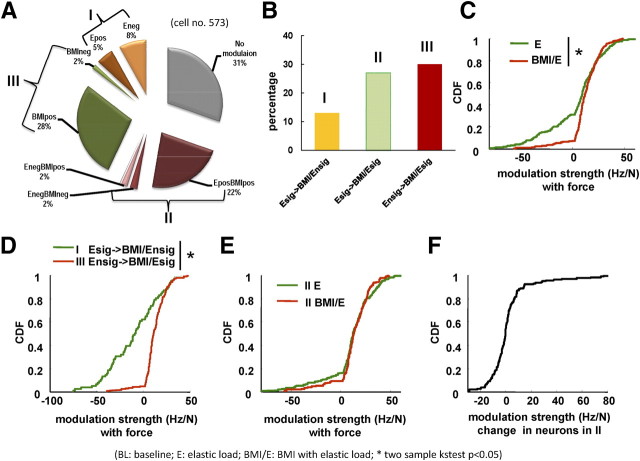Figure 9.
Distribution changes of force-modulated cells between conditions and particularly in BMI. A, B, Of the 573 cells examined, ∼30% of the cells showed no modulation in either simple elastic load or BMI with elastic load conditions (gray). Thirteen percent showed force modulation only in simple elastic load (orange type I, Esig→BMI/Ensig), 30% showed force modulation only in BMI with elastic load condition (green type II, Ensig→BMI/Esig), and 30% showed modulation in both simple elastic load and BMI with elastic load condition (violet red type III, Esig→BMI/Esig). Cells could be either positively or negatively modulated. A small number of modulated cells (2%) in elastic load condition reversed their modulation strength from negative to positive, whereas most of the cells (24%) kept the modulation direction (positive to positive or negative to negative). B, Most of the positively force-modulated cells in BMI with elastic load condition came from new cells that had showed no force modulation in the simple elastic load condition. Thirteen percent of cells showed significant modulation under elastic load only (type I, Esig→BMI/Ensig); 30% of cells showed BMI with elastic load only (type II, Esig→BMI/Esig); 28% of cells showed both elastic load and BMI with elastic load (type III, Ensig→BMI/Esig). More condition specific cells were recruited during BMI with elastic load condition than during elastic load condition. C, There was significant difference in the cumulative distribution of modulation strength for force-modulated cells between simple elastic and BMI with elastic load (kstest2, p < 0.05). More cells were positively force-modulated in the BMI with elastic load condition than simple elastic load. D, There was a significant difference in the distribution of the type I and type II cells. Type I cells (drop outs of significance) were evenly distributed in modulation strength, whereas type III cells (cells newly significantly force related in BMI/E) were most likely positive-force related. E, There was no significant difference in the overall cumulative distribution of modulation strengths of type II cells (cells significantly correlated in both E in BMI/E) between the conditions of elastic field and BMI with elastic field (*significant difference with kstest2, p < 0.05). F, There was no significant modulation strength change of the individual neurons in group II between simple elastic load and BMI with elastic load.

